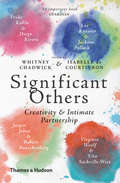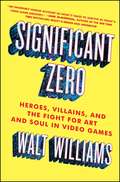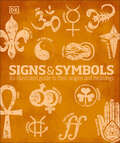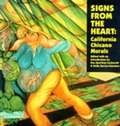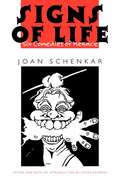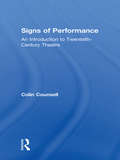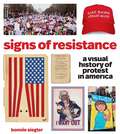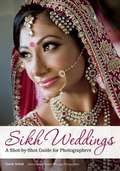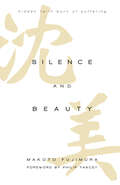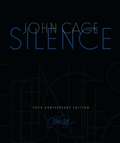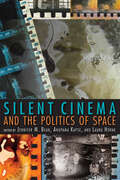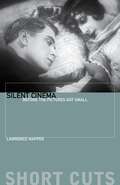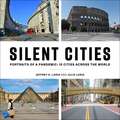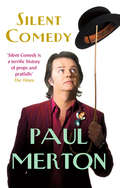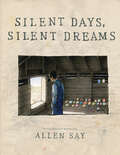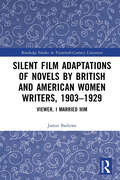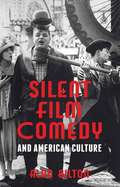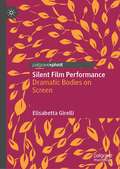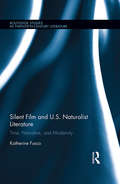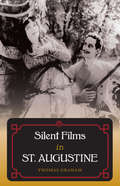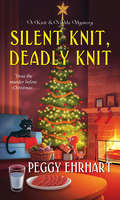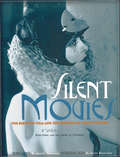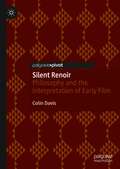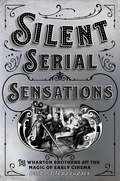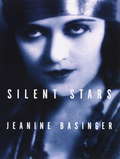- Table View
- List View
Significant Others: Creativity And Intimate Partnership (Interplay Ser.)
by Whitney ChadwickBiographies of artists and writers have traditionally presented an individual's lone struggle for self-expression. In this book, critics and historians, challenge these assumptions in a series of essays that focus on artist and writer couples who have shared sexual and artistic bonds. Featuring duos such as Auguste Rodin and Camille Claudel, Sonia and Robert Delaunay, Vanessa Bell and Duncan Grant, and Jasper Johns and Robert Ruaschenberg, this book combines biography with evaluation of each partner's work in the context of the relationship.
Significant Zero: Heroes, Villains, and the Fight for Art and Soul in Video Games
by Walt WilliamsFrom the award-winning videogame writer behind Spec Ops: The Line comes an exclusive behind-the-scenes look at how today’s blockbuster video games are made.When his satirical musings in a college newspaper got him discharged from the Air Force, it became clear to Walt Williams that his destiny in life was to be a writer—he just never thought he’d end up writing video games, let alone working on some of the most successful franchises in the industry—Bioshock, Civilization, Borderlands, and Mafia among others. Williams pulls back the curtain on an astonishingly profitable industry that has put its stamp on pop culture and yet is little known to those outside its walls. In his reflective yet comically-observant voice, Williams walks you through his unlikely and at times inglorious rise within one of the world’s top gaming companies, exposing an industry abundant in brain power and out-sized egos, but struggling to stay innovative. Significant Zero also provides clear-eyed criticism of the industry’s addiction to violence and explains how the role of the narrative designer—the poor soul responsible for harmonizing gameplay with storylines—is crucial for expanding the scope of video games into more immersive and emotional experiences. Significant Zero offers a rare look inside this fascinating, billion-dollar industry and a path forward for its talented men and women—gamers and nongamers alike—that imagines how video games might inspire the best in all of us.
Signs and Symbols: An Illustrated Guide to Their Origins and Meanings (DK Compact Culture Guides)
by DKSince when did certain hand gestures become offensive? And why are scales a symbol of justice? For thousands of years, humans have communicated through a language of signs and symbols. From uniforms to body adornment and corporate logos, symbols are everywhere, and this book is your guide to their secret meanings and history.The Sun as well as the night sky with its stars and planets has long been used to symbolize supernatural forces. Learn about this and also how humans have used patterns, numbers, clothing, and more to signal authority, kinship, and status. Signs & Symbols decodes over 2000 emblems, explaining the visual language of architecture, heraldry, religion, and death. It answers questions such as why, for example, Christianity is symbolized by a fish, or how the Chinese use the crane bird to signify longevity. This comprehensive book also explores how certain gemstones or flowers became linked to personal qualities and how the alphabet and national flags came into being. Signs & Symbols will open your eyes to the fascinating world of symbolism that is embedded in every area of our lives.
Signs from the Heart: California Chicano Murals
by Eva Sperling Cockcroft Holly Barnet-SanchezA book about murals by Chicano artists in California.
Signs of Life: Six Comedies of Menace
by Joan M. SchenkarJoan Schenkar, widely regarded as America's most original female contemporary playwright, is the author of numerous experimental plays which she refers to as "comedies of menace." Bristling with wit and intelligence, the collection features Signs of Life, Cabin Fever, The Universal Wolf, Burning Desires, The Last of Hitler, and Fulfilling Koch's Postulate. These plays explore issues of feminism and gender politics, history and memory, sexuality and violence, bringing to life such figures as Gertrude Stein and Marlene Dietrich, Hitler and Eva Braun, P. T. Barnum and Henry and Alice James, Claude Levi-Strauss and Roland Barthes. Schenkar's charged language and evocative stage directions invite the reader to become both performer and audience, and the experience is enhanced both by richly evocative stage directions and illustrations from productions of the plays. Initially written to be read like novels as well as staged, the plays provide a unique theatrical experience, an experience that can only be accessed by laughter.
Signs of Performance: An Introduction to Twentieth-Century Theatre
by Colin CounsellSigns of Performance provides the beginning student with working examples of theatrical analysis. Its range covers the whole of twentieth century theatre, from Stanislavski to Brecht and Samuel Beckett to Robert Wilson. Colin Counsell takes an historical look at theatre as a cultural practice, clearly tracing connections between: * Key practitioners' ideas about performance * The theatrical practices prompted by those ideas * The resulting signs which emerge in performance * The meanings and political consequences of those signs It provides an understandable theoretical framework for the study of theatre as a an signifying practice, and offers vivid explanations in clear, direct language. It opens up this fascinating field to a broad audience.
Signs of Resistance: A Visual History of Protest in America
by Bonnie Siegler“Clever images of dissent are not a recent phenomenon in the United States. . . . [Signs of Resistance is] visually fascinating. . . . [and] there is bigly wit here, too.”—The Washington Post In hundreds of iconic, smart, angry, clever, unforgettable images, Signs of Resistance chronicles what truly makes America great: citizens unafraid of speaking truth to power. Two hundred and forty images—from British rule and women’s suffrage to the civil rights movement and the Vietnam War; from women’s equality and Black Lives Matter to the actions of our forty-fifth president and the Women’s March—offer an inspiring, optimistic, and visually galvanizing history lesson about the power people have when they take to the streets and stand up for what’s right.
Sikh Weddings: A Shot-by-shot Guide For Photographers
by Gurm SohalSikh weddings are vibrant, ritual-steeped events that can stretch on for days. Each wedding is unique and unforgettable. Photographing them is a joy and a challenge: there are countless facets to photograph -- and many moments seeped in meaning and tradition. Documenting can’t-miss moments as they unfold requires a comprehensive understanding of the elements of the wedding, from start to finish. Sohal teaches readers the ins and outs of photographing the Sikh wedding. He offers general guidelines -- greetings to use with men versus those to use with women -- and moves on to share some pointers regarding general expectations the family will have of the photographer (e. g. , never refuse food -- that would be impolite; expect to take far more family photos than you may be accustomed to). Next, he describes the major events of the wedding and explains the significance of each. With easy to digest text and gorgeous illustrations, this book is not to be missed.
Silence and Beauty: Hidden Faith Born of Suffering
by Makoto Fujimura2017 Logos Bookstore Association Award for Christianity/Culture2017 Dallas Willard Center Book Award FinalistForeword INDIES 2016 Book of the Year Awards FinalistWorld Magazine's Best Books of 2016 Short List2016 Aldersgate Prize by the John Wesley Honors College at Indiana Wesleyan UniversityEvangelical Christian Publishers Association Top Shelf Book Cover Award14th Annual Outreach Magazine Resource of the Year, Counseling and RelationshipsMissio Alliance Essential Reading List of 2016
Silence: Lectures and Writings (50th Anniversary Edition)
by John Cage Kyle GannSilence, John Cage's first book and epic masterpiece, was published in October 1961. In these lectures, scores, and writings, Cage tries, as he says, to find a way of writing that comes from ideas, is not about them, but that produces them. Often these writings include mesostics and essays created by subjecting the work of other writers to chance procedures using the I Ching. Fifty years later comes a beautiful new edition with a foreword by eminent music critic Kyle Gann. A landmark book in American arts and culture, Silence has been translated into more than forty languages and has sold over half a million copies worldwide. Wesleyan University Press is proud to celebrate the fiftieth anniversary of the book's publication with this special hardcover edition.
Silent Cinema and the Politics of Space (New Directions in National Cinemas)
by Jennifer M. Bean, Anupama Kapse and Laura HorakIn this cross-cultural history of narrative cinema and media from the 1910s to the 1930s, leading and emergent scholars explore the transnational crossings and exchanges that occurred in early cinema between the two world wars. Drawing on film archives from around the world, this volume advances the premise that silent cinema freely crossed national borders and linguistic thresholds in ways that became far less possible after the emergence of sound. These essays address important questions about the uneven forces–geographic, economic, political, psychological, textual, and experiential–that underscore a non-linear approach to film history. The "messiness" of film history, as demonstrated here, opens a new realm of inquiry into unexpected political, social, and aesthetic crossings of silent cinema.
Silent Cinema: Before the Pictures Got Small (Short Cuts)
by Lawrence NapperSince the spectacular success of The Artist (2011) there has been a resurgence of interest in silent cinema, and particularly in the lush and passionate screen dramas of the 1920s. This book offers an introduction to the cinema of this extraordinary period, outlining the development of the form between the end of the First World War and the introduction of synchronized sound at the end of the 1920s. Lawrence Napper addresses the relationship between film aesthetics and the industrial and political contexts of film production through a series of case studies of "national" cinemas. It also focuses on film-going as the most popular leisure activity of the age. Topics such as the star system, cinema buildings, musical accompaniments, film fashions, and fan cultures are addressed—all the elements that ensured that the experience of the pictures was "big." The international dominance of Hollywood is outlined, as are the different responses to that dominance in Britain, Germany, and the USSR. Case studies seek to move beyond the familiar silent canon, and include The Oyster Princess (1919), It (1927), Shooting Stars (1927), and The Girl with the Hatbox (1927).
Silent Cities: Portraits of a Pandemic: 15 Cities Across the World
by Julie Loria Jeffrey H. LoriaA moving, recognizable look at life on lockdown and the effect the coronavirus pandemic had across the world—because every city had a story to tell, and at the end of it all, we were all in it together. In the past year, hospitals filled, highways and subways emptied, landmarks and parks were deserted, our healthcare workers became increasingly fatigued and frustrated, and nearly all human activity paused. In photographs, The Great Wall and The Colosseum look photoshopped, with no tourists in sight. This book is unique in that it creates a visual narrative to document that emptiness as a way to reflect and to find solace amid the shock. A year later, it's something we've all seen and can relate to. This is a stunning collection of the abandoned and austere sights of fifteen major cities throughout the world during the peak outbreak of COVID-19. With their fine art backgrounds and through their network of professional photographers, Julie and Jeffrey Loria worked together to capture the unprecedented lockdown conditions worldwide. The photos show a range of emotions from the physical and psychological weight of caskets being carried to a Rio cemetery, to the completely empty and eerie Times Square and Rodeo Drive, to the patriotic pride in Rome's t-shirt display honoring their Italian flag colors as a symbol of hope. The photographs are not only a reminder of the harrowing pandemic that hushed some of the world&’s greatest urban streets, but also proof that across the globe, we were all in this together. Beneath the somberness in these images, there is a hint of beauty amid the stillness, but most of all, there is the presence of hope and promise that we will thrive again. Cities featured include: New YorkJerusalemBostonTokyoParisLos AngelesRomeRio de JaneiroSan FranciscoWashington, DCLondonMiamiTel AvivMadridChicago
Silent Comedy
by Paul MertonOn the surface it may seem slightly surprising that a master of verbal humour should also be a devotee of silent comedy, but Paul Merton is completely passionate about the early days of Hollywood comedy and the comic geniuses who dominated it. His knowledge is awesome - as anyone who watched his BBC 4 series Silent Clowns or attended the events he has staged nationwide will agree - his enthusiasm is infectious, and these qualities are to be found in abundance in his book. Starting with the very earliest pioneering short films, he traces the evolution of silent comedy through the 1900s and considers the works of the genre's greatest exponents - Buster Keaton, Charlie Chaplin, Laurel and Hardy and Harold Lloyd - showing not only how each developed in the course of their career but also the extent to which they influenced each other. At the same time, Paul brings a comedian's insight to bear on the art of making people laugh, and explores just how the great comic ideas, routines, gags and pratfalls worked and evolved. His first book for ten years, this is destined to be a classic.
Silent Days, Silent Dreams
by Allen SayCaldecott Medal winner Allen Say brings his lavish illustrations and hybrid narrative and artistic styles to the story of artist James Castle.James Castle was born two months premature on September 25, 1899, on a farm in Garden Valley, Idaho. He was deaf, mute, autistic, and probably dyslexic. He didn't walk until he was four; he would never learn to speak, write, read, or use sign language.Yet, today Castle's artwork hangs in major museums throughout the world. The Philadelphia Museum of Art opened "James Castle: A Retrospective" in 2008. The 2013 Venice Biennale included eleven works by Castle in the feature exhibition "The Encyclopedic Palace." And his reputation continues to grow.Caldecott Medal winner Allen Say, author of the acclaimed memoir Drawing from Memory, takes readers through an imagined look at Castle's childhood, allows them to experience his emergence as an artist despite the overwhelming difficulties he faced, and ultimately reveals the triumphs that he would go on toachieve.
Silent Film Adaptations of Novels by British and American Women Writers, 1903-1929: Viewer, I Married Him (Routledge Studies in Twentieth-Century Literature)
by Jamie BarloweSilent Film Adaptations of Novels by British and American Women Writers, 1903–1929 focuses on fifty-three silent film adaptations of the novels of acclaimed authors George Eliot, Charlotte Brontë, Emily Brontë, Mary Shelley, Louisa May Alcott, Harriet Beecher Stowe, Willa Cather, and Edith Wharton. Many of the films are unknown or dismissed, and most of them are degraded, destroyed, or lost—burned in warehouse fires, spontaneously combusted in storage cans, or quietly turned to dust. Their content and production and distribution details are reconstructed through archival resources as individual narratives that, when considered collectively, constitute a broader narrative of lost knowledge—a fragmented and buried early twentieth-century story now reclaimed and retold for the first time to a twenty-first-century audience. This collective narrative also demonstrates the extent to which the adaptations are intertextually and ideologically entangled with concurrently released early “woman’s films” to re-promote and re-instill the norm of idealized white, married, domesticated womanhood during a time of extraordinary cultural change for women. Retelling this lost narrative also allows for a reassessment of the place and function of the adaptations in the development of the silent film industry and as cinematic precedent for the hundreds of sound adaptations of the literary texts of these eight women writers produced from 1931 to the 2020s.
Silent Film Comedy and American Culture
by Alan BiltonBilton's study of early 20th century American culture interprets the anarchic absurdity of slapstick movies as a form of collective anxiety dream, their fantastical images and illogical gags bypassing rational thought to express the unconscious fears, wishes and concerns of the modern age. Silent film comedy, with its childlike love of the illogical, the destructive and the anti-social, seems to suggest a form of comic revolt against the mechanisation and the uniformity of the machine age, but the book also charts how a new consumer culture sought simultaneously to tame and contain these energies, redirecting them in the service of a newly emergent mass culture. Not just a film history of the silent era, Bilton also provides a provocative and lively engagement with the origins of mass culture, tracing the origins of Hollywood's dream factory and alongside it the roots of our own irrational, childlike, celebrity-obsessed consumer culture.
Silent Film Performance: Dramatic Bodies on Screen
by Elisabetta GirelliThis book provides a groundbreaking exploration of silent film performance. It combines close reading of silent screen acting with theoretically informed analysis, stressing the overlap between different performative arts, such as film and stage acting, dance, mime, and pantomime. The boundary between silent and sound films is also challenged. Anna Pavlova’s acting in The Dumb Girl of Portici is read through Freud’s work on the uncanny, disability studies, and notions of intermediality. Vladimir Mayakovsky’s performance in The Young Lady and the Hooligan is approached as a silent soliloquy and a representation of loneliness. Ivan Mozzhukhin’s tour de force in The Late Mathias Pascal is discussed through a queer failure lens, while Pola Negri’s presence in Hotel Imperial is analysed with the aid of texts on wartime anxiety. Harald Kreutzberg’s stunning number in Paracelsus is examined in the light of theories of mime and pantomime, arguing for its subversive potential in a Third Reich sound film.
Silent Film and U.S. Naturalist Literature: Time, Narrative, and Modernity (Routledge Studies in Twentieth-Century Literature)
by Katherine FuscoTypically, studies of early cinema’s relation to literature have focused on the interactions between film and modernism. When film first emerged, however, it was naturalism, not modernism, competing for the American public’s attention. In this media ecosystem, the cinema appeared alongside the works of authors including Charlotte Perkins Gilman, Jack London, and Frank Norris. Drawing on contemporaneous theories of time and modernity as well as recent scholarship on film, narrative, and naturalism, this book moves beyond traditional adaptation studies approaches to argue that both naturalism and the early cinema intervened in the era’s varying experiments with temporality and time management. Specifically, it shows that American naturalist novels are constructed around a sustained formal and thematic interrogation of the relationship between human freedom and temporal inexorability and that the early cinema developed its norms in the context of naturalist experiments with time. The book identifies the silent cinema and naturalist novel’s shared privileging of narrative progress over character development as a symbolic solution to social and aesthetic concerns ranging from systems of representation, to historiography, labor reform, miscegenation, and birth control. This volume thus establishes the dynamic exchange between silent film and naturalism, arguing that in the products of this exchange, personality figures as excess bogging down otherwise efficient narratives of progress. Considering naturalist authors and a diverse range of early film genres, this is the first book-length study of the reciprocal media exchanges that took place when the cinema was new. It will be a valuable resource to those with interests in Adaptation Studies, American Literature, Film History, Literary Naturalism, Modernism, and Narrative Theory.
Silent Films in St. Augustine
by Thomas Graham“This absorbing tale, documenting the forgotten history of early moviemaking in St. Augustine, is a must-read for film enthusiasts.”—Janelle Blankenship , coeditor of European Visions: Small Cinemas in Transition “Very few people have any idea that St. Augustine played any role in early film history. This book brings St. Augustine into a much larger film conversation.”—Christina Lane, author of Magnolia “This richly detailed book tells the story of early filmmakers’ adventures in St. Augustine and captures the excitement of their moviemaking escapades.”—Kathryn Fuller-Seeley, coauthor of One Thousand Nights at the Movies: An Illustrated History of Motion Pictures, 1895–1915 “Given that the great majority of these early films are now lost, Graham makes an important contribution to the study of Florida’s image on film.”—Jan-Christopher Horak, author of Saul Bass: Anatomy of Film Design “The ‘reel’ history of Florida and its contribution to the development of American film history has been left out of mainstream textbooks and accounts. Thomas Graham’s book is a link in the chain of that history and an important addition to film scholarship.”—Susan Doll, coauthor of Florida on Film: The Essential Guide to Sunshine State Cinema and Locations “Through entertaining stories of how St. Augustine lured studios and enriched filmmaking with Henry Flagler’s railroad and architecture, Graham adds new detail to our understanding of the silent film era.”—Rita Reagan, Norman Studios Silent Film Museum Before Hollywood, when America’s rising motion picture industry was based on the East Coast, early film stars like Rudolph Valentino, Thomas Meighan, Ethel Barrymore, and Oliver Hardy made movies in St. Augustine, Florida. Silent Films in St. Augustine tells stories of the leading film producers and actors who escaped New York winters—and kept the studio doors open—in St. Augustine’s sunshine and warm weather. Scenes for more than 120 films were made in St. Augustine from 1906 to 1926 by film companies including Thanhouser, Lubin, Éclair, Pathé, Edison, Vitagraph, and Paramount. The first feature-length Frankenstein movie, Life Without Soul, was partly shot in St. Augustine. Theda Bara became a “vamp” sensation for her role in A Fool There Was. Sidney Drew acted in the genderbending A Florida Enchantment. Noted directors Edwin S. Porter, Maurice Tourneur, and George Fitzmaurice also set up shop in the beach town. Filmmakers used St. Augustine’s striking architecture to create backdrops for movies set in exotic foreign locales. The famous Castillo de San Marcos, the stone houses on the narrow streets, and Henry Flagler’s Spanish Renaissance palace hotels were reimagined as Spain, Italy, France, Egypt, Arabia, South Africa, Brazil, and Hawaii. Residents of St. Augustine loved seeing film teams in action on their streets and would gather around the camera to watch the actors and marvel at the outlandish costumes. Cast as extras in larger productions, locals packed theater houses to catch a glimpse of themselves and their neighbors on the screen. Describing the lavish sets, theatrical action, and New York movie personalities that filled St. Augustine, Thomas Graham evokes an intensely creative time and place in the history of American moviemaking.
Silent Knit, Deadly Knit (A Knit & Nibble Mystery #4)
by Peggy EhrhartWhen murder silences the Christmas cheer in charming Arborville, New Jersey, Pamela and her Knit and Nibble pals must unravel the most bone-chilling mystery this side of the North Pole . . . Pamela has been in merry spirits since her artsy daughter Penny returned home from college for the holidays. But their mother-daughter bonding time gets cut short when a terrified Penny stumbles upon the dumped body of Millicent Farthingale, a wealthy craft shop owner who was popular for all the wrong reasons. From a scheming business partner to a seedy husband several years her junior, Millicent attracted scammers so in love with her assets, they’d toss her down a chimney to get their paws on them. Now, with only a hand-knit red scarf connecting the killer to the crime, Pamela and the Knit and Nibblers could use some extra creativity as they find out who’s really naughty or nice in Arborville—because going up against a looming culprit is DIY or die! Knitting tips and delicious recipe included!
Silent Movies: The Birth of Film and the Triumph of Movie Culture
by Peter Kobel Martin Scorsese Kevin BrownlowA gorgeous, lavish history of silent movies - with more than 400 amazing images - captures the birth of film and icons like Chaplin, Garbo, Clara Bow, and Valentino. Drawing on the extraordinary collection of The Library of Congress, one of the greatest repositories for silent film and memorabilia, Peter Kobel has created the definitive visual history of silent film. From its birth in the 1890s, with the earliest narrative shorts, through the brilliant full-length features of the 1920s, SILENT MOVIES captures the greatest directors and actors and their immortal films. SILENT MOVIES also looks at the technology of early film, the use of color photography, and the restoration work being spearheaded by some of Hollywood's most important directors, such as Martin Scorsese and Francis Ford Coppola. Richly illustrated from the Library of Congress's extensive collection of posters, paper prints, film stills, and memorabilia-most of which have never been in print-SILENT MOVIES is an important work of history that will also be a sought-after gift book for all lovers of film.
Silent Renoir: Philosophy and the Interpretation of Early Film
by Colin DavisJean Renoir (1894-1979) is widely regarded as one of the most distinguished directors in the history of world cinema. In the 1930s he directed a string of films which stretched the formal, intellectual, political and aesthetic boundaries of the art form, including works such as Le Crime de Monsieur Lange, La Grande Illusion, La Bête humaine and La Règle du jeu. However, the great director’s early work from the 1920s remains almost completely unknown, even to film specialists. If it is discussed at all, it is often seen to be of interest only insofar as it anticipates themes and techniques perfected in the later masterpieces. Renoir’s films of the 1920s were sometimes unfinished, commercially unsuccessful, or unreleased at the time of their production. This book argues that to regard them merely as prefigurations of later achievements entails a failure to view them on their own terms, as searching, unsettled experiments in the meaning and potential of film art.
Silent Serial Sensations: The Wharton Brothers and the Magic of Early Cinema
by Barbara Tepa LupackThe first book-length study of pioneering and prolific filmmakers Ted and Leo Wharton, Silent Serial Sensations offers a fascinating account of the dynamic early film industry. As Barbara Tepa Lupack demonstrates, the Wharton brothers were behind some of the most profitable and influential productions of the era, including The Exploits of Elaine and The Mysteries of Myra, which starred such popular performers as Pearl White, Irene Castle, Francis X. Bushman, and Lionel Barrymore. Working from the independent film studio they established in Ithaca, New York, Ted and Leo turned their adopted town into "Hollywood on Cayuga." By interweaving contemporary events and incorporating technological and scientific innovations, the Whartons expanded the possibilities of the popular serial motion picture and defined many of its conventions. A number of the sensational techniques and character types they introduced are still being employed by directors and producers a century later.
Silent Stars
by Jeanine BasingerFrom one of America's most renowned film scholars: a revelatory, perceptive, and highly readable look at the greatest silent film stars -- not those few who are fully appreciated and understood, like Chaplin, Keaton, Gish, and Garbo, but those who have been misperceived, unfairly dismissed, or forgotten. Here is Valentino, "the Sheik," who was hardly the effeminate lounge lizard he's been branded as; Mary Pickford, who couldn't have been further from the adorable little creature with golden ringlets that was her film persona; Marion Davies, unfairly pilloried in Citizen Kane; the original "Phantom" and "Hunchback," Lon Chaney; the beautiful Talmadge sisters, Norma and Constance. Here are the great divas, Pola Negri and Gloria Swanson; the great flappers, Colleen Moore and Clara Bow; the great cowboys, William S. Hart and Tom Mix; and the great lover, John Gilbert. Here, too, is the quintessential slapstick comedienne, Mabel Normand, with her Keystone Kops; the quintessential all-American hero, Douglas Fairbanks; and, of course, the quintessential all-American dog, Rin-Tin-Tin.This is the first book to anatomize the major silent players, reconstruct their careers, and give us a sense of what those films, those stars, and that Hollywood were all about. An absolutely essential text for anyone seriously interested in movies, and, with more than three hundred photographs, as much a treat to look at as it is to read.
